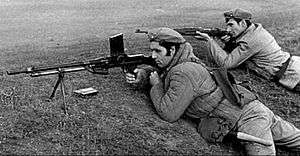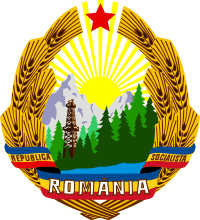Patriotic Guards (Romania)

| Part of a series on the |
| Socialist Republic of Romania |
|---|
 |
|
Relationship with the USSR |
The Patriotic Guards (Romanian: Gărzile patriotice) were Romanian paramilitary formations formed during the Communist era, designed to provide additional defense in case of outside attack.
History

The Guards were formed in 1968, after the August 21 Bucharest speech through which Romanian leader Nicolae Ceauşescu condemned the crushing of the Prague Spring by Soviet forces. Ceauşescu appealed to anti-Soviet sentiments within the general population to ask for resistance against the perceived threat of a similar Soviet manoeuvre against Romania itself. The nationalist themes he used had their immediate effect in the rallying of large portions of the public, who began organizing and arming themselves under direction of the Romanian Communist Party.
Although the threat was over by the end of the year, the Guards remained a feature of the country's communist structure. They became a permanent addition to the regular military, and compulsory training was introduced for young men and women. For university students, this meant that hours of the curriculum were reserved for shooting drills and other training courses; soon, they were doubled by additional requirements for work in the fields (that was asked from high school and older primary school students, as well as their teachers).
No longer backed by enthusiasm as they had been in the early 1970s, the Guards nonetheless were the basic line of defense against projected invasions. The threat posed by the latter seemed to increase as the regime plunged into isolation, especially after it lost the support of the Western Bloc in the early 1980s. From that point on, the Guards were to become part of the State's apparatus of repression against its own people.
During the Romanian Revolution of 1989, Ceauşescu attempted to use them against protesters (notably, in Timişoara). However, the pace of events and the breadth of hostility to his regime outstripped this plan. As the Revolution progressed, many Patriotic Guard members (who like most other Romanians were fed up with Ceaucescu's failed economic policies and suffering from declining living standards) actually joined the protesters. To no small extent, the people who were meant to be armed in case of the disturbances were in fact the ones causing them.
Function
The Patriotic Guards was an all inclusive public security organization, its functions included normal civil policing and fire-fighting, and a very large "People's Militia" force. During wartime it would provide rear area security, augment the ground forces, and operate as guerrillas if and when their areas were overrun by invaders.
Place in the official ideology
In the 1980s, Romanian communism took on a militarized form. Ilie Ceauşescu, Romanian Army general and brother of Nicolae, summarized the new traits in his Istoria militară a poporului român ("The Military History of the Romanian People"). The work (soon turned into official dogma) argued that the Romanians had always had the largest standing army in the world—notably, he consistently chose to add up the entire population as present under arms. This constituted a message for the future, since the regime had established a strong connection with all past forms. As such, the ideology behind the formation of the Guards was rendered as the War of the Entire People military doctrine.
Organization

The Patriotic Guards were staffed by about 700,000 citizens in 1989, both men and women. In keeping with the doctrine of War of the Entire People, the Patriotic Guards were a combined territorial defense or national guard and civil defense organization, which was established immediately after the Soviet-led Warsaw Pact invasion of Czechoslovakia. The Patriotic Guards worked closely with the Ministry of National Defense but were directly subordinate to the PCR and the UTC. Relying more on ordinary citizens than on the professional military, the Patriotic Guards served as a potential counterweight to or check on the power and influence of the regular armed forces.
In 1989 the Patriotic Guards were organized into company- and platoon-sized units in almost every judet, municipality, town, village, and industrial or agricultural enterprise. Under the command of the first secretary of the local PCR apparatus, they conducted basic and refresher training in small-arms handling, demolition, mortar and grenade-launcher firing, and small-unit tactics. In wartime they had responsibility for local antiaircraft defense, providing early warning of air attack, defending population centers and important elements of national infrastructure, and conducting civil engineering work as needed to reestablish essential military production after an attack. They would reconnoiter and attack enemy flanks and rear areas, combat airborne units and special forces penetrating deep into Romania, and mount resistance operations against occupying forces. In keeping with their guerrilla image, the Patriotic Guards wore plain uniforms with no insignia or badges of rank.
References
![]() This article incorporates public domain material from the Library of Congress Country Studies website http://lcweb2.loc.gov/frd/cs/.
This article incorporates public domain material from the Library of Congress Country Studies website http://lcweb2.loc.gov/frd/cs/.
- Lucian Boia, Istorie şi mit în conştiinţa românească ("History and myth in the Romanian conscience"), Bucharest, Humanitas, 1997.
- Mihai Retegan, 1968 - Din primăvară până în toamnă ("1968 - From spring to autumn"), Bucharest, RAO, 1998.
External links
- Military structure and armament of the Patriotic Guards
- Dieter Schlesak interviewed: in the opening paragraphs, he describes his enthusiastic joining of the Guards to fight "against the Russians" (in Romanian)